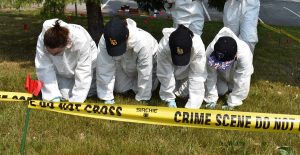This year’s BCIT Forensics Field School kicked-off with an extensive outdoor mock crime scene day on Burnaby Campus.
The two-week, hands-on program offers international forensic experience to 25 Criminology and Criminal Justice undergraduates from the California State University Long Beach (Cal State). It’s the first time the session has run since 2019.
“In recent years, both the US and Canada have seen several major crimes, such as drug trafficking, weapon smuggling, and illegal immigrants, becoming more transnational,” explains Professor John Wang, from Cal State, who has accompanied the students. “So, we know we need to understand situations beyond the US borders.”
“This opportunity better prepares our students to work on transnational crime cases with an understanding of the Canadian approach to forensic science, thanks to BCIT’s great instructors and facilities.” – Professor John Wang, California State University Long Beach
It’s the sixth time Professor Wang has brought a group from Cal State, and he says there are several strong reasons for it. “First, the combination of the field work and lab examination fits our students with a criminal justice major with a forensic studies minor. Second, the instructor team consists of both university professors and practitioners from various Canadian agencies, including crown prosecutor, defense, law enforcement, medical examination, and intelligence. Finally, we have opportunities to visit agencies and courthouses and see their real daily routines, which is also very valuable.”
Crime scene evidence collection and processing

During crime scene day, students acted as forensic examiners called on-scene to investigate a suspicious car accident. Police have found a deceased individual slumped over the passenger seat of a truck. Students arrived dressed in full crime scene – also known as “bunny” – suits. Instructors briefed students with a police log describing the scene encountered by police, and accompanying relevant details of what occurred prior to the forensic investigators’ processing. They were then led through the actual phases of incident investigation and best practices in evidence collection, such as dusting for fingerprints.

Following the crime scene immersion, students moved into lab work and legal issues such as court testimony. Diverse industry experts taught their particular specialty, including DNA, fingerprinting, drug analysis, and digital forensics.
“I have enjoyed the class here at BCIT because we got hands-on experience taught by BCIT instructors working in the forensic science industry,” reports student America Lopez. “The fingerprints lecture and lab were my favourite part so far because I enjoy looking at patterns and learning how to use this technology.” Check out the fingerprint lab photos.
Exploring the breath of forensics – from cybersecurity to DNA analysis
“BCIT offers the most comprehensive Forensic Science and Technology programming in Canada,” explains Jason Moore, BCIT Forensics faculty and camp coordinator. “We cover forensic science, crime and intelligence analysis, digital forensics and cybersecurity, and forensic health science.”
“We have a lot to offer our guest students, from our breadth to specific facilities,” says Jason. “BCIT is the only academic institute in Canada with a Forensic DNA lab that’s accredited by the Standards Council of Canada. This is the same level of accreditation held by the Royal Canadian Mounted Police’s lab.”
Global TV and Fairchild also visited the mock crime scene.
Subscribe to the twice-yearly Forensics Investigator and keep up with the latest.
